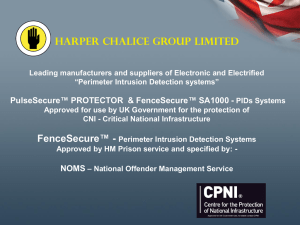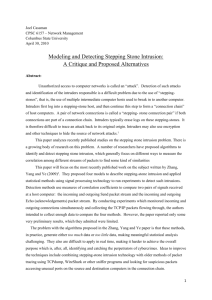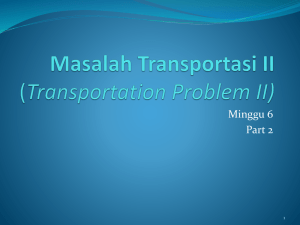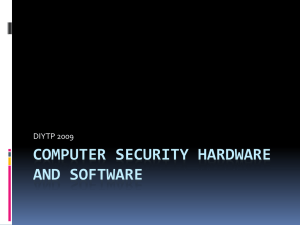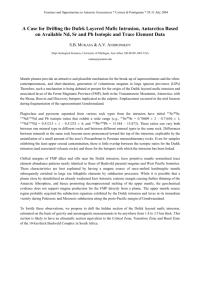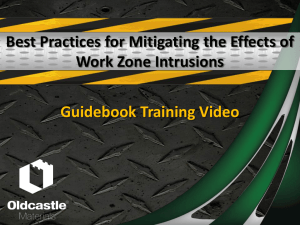CPSC 4899 - Wang - TSYS School of Computer Science
advertisement
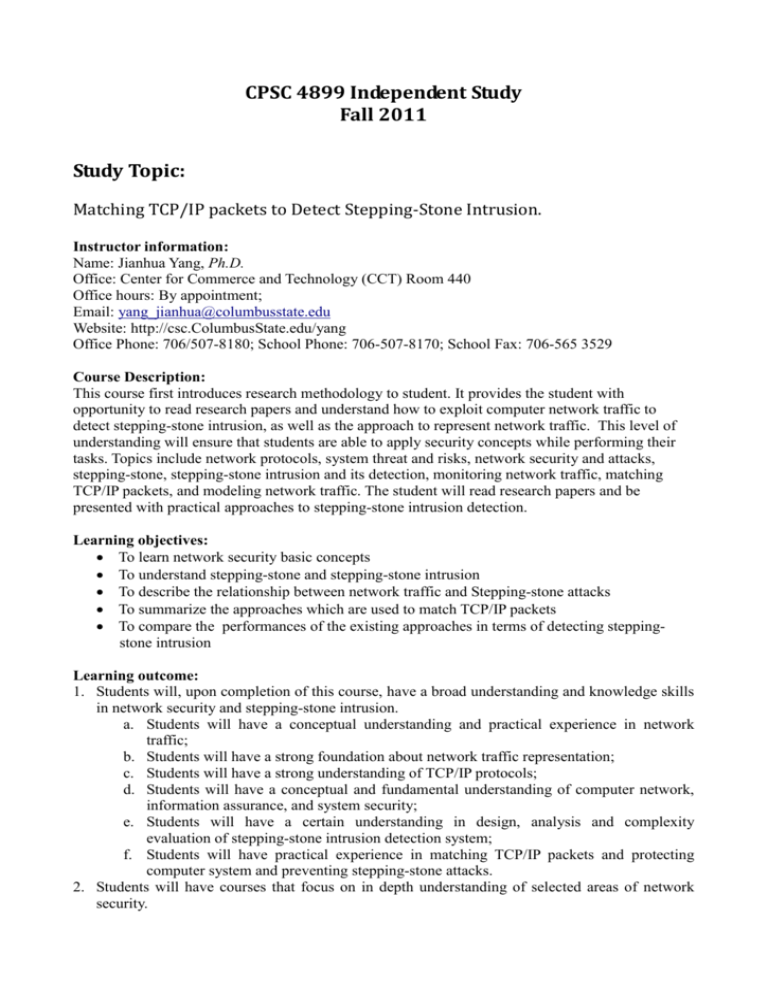
CPSC 4899 Independent Study Fall 2011 Study Topic: Matching TCP/IP packets to Detect Stepping-Stone Intrusion. Instructor information: Name: Jianhua Yang, Ph.D. Office: Center for Commerce and Technology (CCT) Room 440 Office hours: By appointment; Email: yang_jianhua@columbusstate.edu Website: http://csc.ColumbusState.edu/yang Office Phone: 706/507-8180; School Phone: 706-507-8170; School Fax: 706-565 3529 Course Description: This course first introduces research methodology to student. It provides the student with opportunity to read research papers and understand how to exploit computer network traffic to detect stepping-stone intrusion, as well as the approach to represent network traffic. This level of understanding will ensure that students are able to apply security concepts while performing their tasks. Topics include network protocols, system threat and risks, network security and attacks, stepping-stone, stepping-stone intrusion and its detection, monitoring network traffic, matching TCP/IP packets, and modeling network traffic. The student will read research papers and be presented with practical approaches to stepping-stone intrusion detection. Learning objectives: To learn network security basic concepts To understand stepping-stone and stepping-stone intrusion To describe the relationship between network traffic and Stepping-stone attacks To summarize the approaches which are used to match TCP/IP packets To compare the performances of the existing approaches in terms of detecting steppingstone intrusion Learning outcome: 1. Students will, upon completion of this course, have a broad understanding and knowledge skills in network security and stepping-stone intrusion. a. Students will have a conceptual understanding and practical experience in network traffic; b. Students will have a strong foundation about network traffic representation; c. Students will have a strong understanding of TCP/IP protocols; d. Students will have a conceptual and fundamental understanding of computer network, information assurance, and system security; e. Students will have a certain understanding in design, analysis and complexity evaluation of stepping-stone intrusion detection system; f. Students will have practical experience in matching TCP/IP packets and protecting computer system and preventing stepping-stone attacks. 2. Students will have courses that focus on in depth understanding of selected areas of network security. 3. Students will be able to communicate effectively both orally and in written reports. 4. Students will have the knowledge and skills to pursue careers in industry and/or higher education degree programs. 5. Students will be able to integrate their knowledge and skills into evolving technologies in computer network security. STUDY PLAN AND ASSESSMENT SCHEDULE Week 1-5: Learning objective: To learn network security basic concepts To understand stepping-stone and stepping-stone intrusion Method: Read textbook “Network Security” fundamentals, Mark Ciampa. Assessment: Oral test about the computer network and security basics (20% of grade) Weeks 6-10: Learning objective: To describe the relation between network traffic and Stepping-stone attacks To summarize the approaches which are used to match TCP/IP packets Method: Read the following papers, Blum, A., Song, D., and Venkataraman, S.: Detection of Interactive Stepping-Stones: Algorithms and Confidence Bounds. In: Proc. of 7th International Symposium on Recent Advance in Intrusion Detection. LNCS, vol. 3224, pp. 296-314. Springer Press, Heidelberg (2004) Donoho, D.L., Flesia, A.G., Shankar, U., Paxson, V., Coit, J., and Stuart Staniford, S.: Detecting Pairs of Jittered Interactive Streams by Exploiting Maximum Tolerable Delay. In: Proc. of 5th International Symposium on Recent Advances in Intrusion Detection. LNCS, vol. 2516, pp. 45-59, Springer Press, Heidelberg (2002) Yang, J., Lee, B., Huang, S.: Monitoring Network Traffic to Detect Stepping-Stone Intrusion. In: Proc. of 22nd IEEE International Conference on Advanced Information Networking and Applications. Vol. 1, pp. 56-61. IEEE Press, New York (2008) Zhang, Y., Paxson, V.: Detecting Stepping-Stones. In: Proceedings of the 9th USENIX Security Symposium, pp. 67-81, Denver, CO (2000) Yang, J., Huang, S.: Mining TCP/IP Packets to Detect Stepping-Stone Intrusion. In: Journal of Computers and Security, Vol. 26, pp. 479-484. Elsevier Ltd. (2007) Yung, K. H.: Detecting Long Connecting Chains of Interactive Terminal Sessions. In: Proc. of the 5th international conference on Recent advances in intrusion detection. LNCS, vol. 2516, pp. 1-16. Springer Press, Heidelberg (2002) Staniford-Chen, S., Heberlein, L. T.: Holding Intruders Accountable on the Internet. In: Proc. of IEEE Symposium on Security and Privacy, pp. 39-49. Oakland, CA (1995) Yoda, K., Etoh, H.: Finding Connection Chain for Tracing Intruders. In: Proc. of 6th European Symposium on Research in Computer Security. LNCS, vol. 1985, pp. 31-42. Springer Press, Heidelberg (2000) Assessment: After reading these papers, the student needs to give three presentations at a day of Week 6, 8, 10 respectively. A summary needs to be submitted for each paper. (50% of grade). Weeks 11-16: Learning objective: To compare the performances of the existing approaches in terms of detecting steppingstone intrusion Method: Based the papers read before, the student can come up with a report to summarize and compare the performance of different approaches to detect stepping-stone intrusion. Assessment: Submission of a final report. (30% of grade) CSU Academic Honesty Policy Academic dishonesty includes, but is not limited to, activities such as cheating and plagiarism (http://aa.colstate.edu/advising/a.asp#AcademicDishonestyAcademicMisconduct ). It is a basis for disciplinary action. Any work turned in for individual credit must be entirely the work of the student submitting the work. All work must be your own. [For group projects, the work must be done only by members of the group.] You may share ideas but submitting identical assignments (for example) will be considered cheating. You may discuss the material in the course and help one another with debugging; however, any work you hand in for a grade must be your own. A simple way to avoid inadvertent plagiarism is to talk about the assignments, but don't read each other's work or write solutions together unless otherwise directed by your instructor. For your own protection, keep scratch paper and old versions of assignments to establish ownership, until after the assignment has been graded and returned to you. If you have any questions about this, please see your instructor immediately. For assignments, access to notes, the course textbooks, books and other publications is allowed. All work that is not your own, MUST be properly cited. This includes any material found on the Internet. Stealing or giving or receiving any code, diagrams, drawings, text or designs from another person (CSU or non-CSU, including the Internet) is not allowed. Having access to another person's work on the computer system or giving access to your work to another person is not allowed. It is your responsibility to prevent others from having unauthorized access to your work. No cheating in any form will be tolerated. Penalties for academic dishonesty may include a zero grade on the assignment or exam/quiz, a failing grade for the course, suspension from the Computer Science program, and dismissal from the program. All instances of cheating will be documented in writing with a copy placed in the Department’s files. Students will be expected to discuss the academic misconduct with the faculty member and the chairperson. If you have any questions about what is plagiarism, check the following sites: Plagiarism: What It is and How to Recognize and Avoid It Avoiding Plagiarism? Avoiding Plagiarism Avoiding Plagiarism - MASTERING THE ART OF SCHOLARSHIP CSU ADA statement If you have a documented disability as described by the Rehabilitation Act of 1973 (P.L. 933-112 Section 504) and Americans with Disabilities Act (ADA) and would like to request academic and/or physical accommodations please contact Joy Norman at the Office of Disability Services in the Center for Academic Support and Student Retention, Tucker Hall (706) 568-2330, as soon as possible. Course requirements will not be waived but reasonable accommodations may be provided as appropriate.
